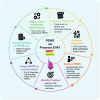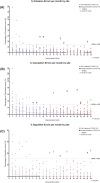Model for regional collaboration: Successful strategy to implement a pediatric early warning system in 36 pediatric oncology centers in Latin America
- PMID: 36161436
- PMCID: PMC9828186
- DOI: 10.1002/cncr.34427
Model for regional collaboration: Successful strategy to implement a pediatric early warning system in 36 pediatric oncology centers in Latin America
Abstract
Background: Pediatric early warning systems (PEWS) aid in the early identification of deterioration in hospitalized children with cancer; however, they are under-used in resource-limited settings. The authors use the knowledge-to-action framework to describe the implementation strategy for Proyecto Escala de Valoracion de Alerta Temprana (EVAT), a multicenter quality-improvement collaborative, to scale-up PEWS in pediatric oncology centers in Latin America.
Methods: Proyecto EVAT mentored participating centers through an adaptable implementation strategy to: (1) monitor clinical deterioration in children with cancer, (2) contextually adapt PEWS, (3) assess barriers to using PEWS, (4) pilot and implement PEWS, (5) monitor the use of PEWS, (6) evaluate outcomes, and (7) sustain PEWS. The implementation outcomes assessed included the quality of PEWS use, the time required for implementation, and global program impact.
Results: From April 2017 to October 2021, 36 diverse Proyecto EVAT hospitals from 13 countries in Latin America collectively managing more than 4100 annual new pediatric cancer diagnoses successfully implemented PEWS. The time to complete all program phases varied among centers, averaging 7 months (range, 3-13 months) from PEWS pilot to implementation completion. All centers ultimately implemented PEWS and maintained high-quality PEWS use for up to 18 months after implementation. Across the 36 centers, more than 11,100 clinicians were trained in PEWS, and more than 41,000 pediatric hospital admissions had PEWS used in their care.
Conclusions: Evidence-based interventions like PEWS can be successfully scaled-up regionally basis using a systematic approach that includes a collaborative network, an adaptable implementation strategy, and regional mentorship. Lessons learned can guide future programs to promote the widespread adoption of effective interventions and reduce global disparities in childhood cancer outcomes.
Lay summary: Pediatric early warning systems (PEWS) are clinical tools used to identify deterioration in hospitalized children with cancer; however, implementation challenges limit their use in resource-limited settings. Proyecto EVAT is a multicenter quality-improvement collaborative to implement PEWS in 36 pediatric oncology centers in Latin America. This is the first multicenter, multinational study reporting a successful implementation strategy (Proyecto EVAT) to regionally scale-up PEWS. The lessons learned from Proyecto EVAT can inform future programs to promote the adoption of clinical interventions to globally improve childhood cancer outcomes.
Keywords: Latin America; global health; implementation science; pediatric early warning system (PEWS); pediatric oncology; quality-improvement collaborative; resource-limited.
© 2022 The Authors. Cancer published by Wiley Periodicals LLC on behalf of American Cancer Society.
Conflict of interest statement
The authors made no disclosures.
Figures




References
-
- Ward ZJ, Yeh JM, Bhakta N, Frazier AL, Atun R. Estimating the total incidence of global childhood cancer: a simulation‐based analysis. Lancet Oncol. 2019;20(4):483‐493. - PubMed
-
- Ward ZJ, Yeh JM, Bhakta N, Frazier AL, Girardi F, Atun R. Global childhood cancer survival estimates and priority‐setting: a simulation‐based analysis. Lancet Oncol. 2019;20(7):972‐983. - PubMed
-
- World Health Organization . Global Initiative for Childhood Cancer. Accessed July 14, 2022. https://www.who.int/publications/m/item/global‐initiative‐for‐childhood‐...
-
- St Jude Children’s Research Hospital . St Jude Global. Accessed March 2, 2020. https://www.stjude.org/global.html
-
- Ceppi F, Antillon F, Pacheco C, et al. Supportive medical care for children with acute lymphoblastic leukemia in low‐ and middle‐income countries. Expert Review Hematol. 2015;8(5):613‐626. - PubMed
Publication types
MeSH terms
LinkOut - more resources
Full Text Sources
Medical
Miscellaneous

